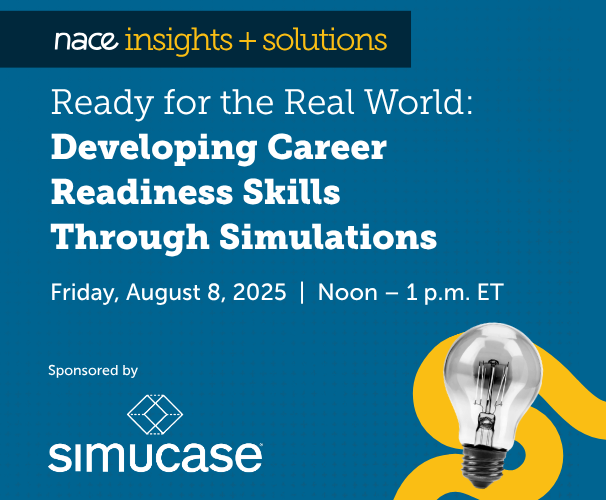Matt Purdy, career services director at Murray State University, explains that during his career, two administrators who came from the world of data—one in Big 4 accounting and the other who promoted analytics—impacted the way he approaches his office’s operations.
“A little of what they used to move their operations forward rubbed off on me,” he says.
“I’ve taken their ideas and implemented them in my unit at Murray State. It’s so valuable in different areas, but especially being able to tell our story, even if we’re not in the same room as our administrators or other decision makers. We’d all love to be in those meetings, but sometimes that doesn’t happen, so you have to give whoever is advocating for you as much strength as possible; data are the key for doing this.”
Purdy advises career services professionals to think about the resources they are trying to obtain and find data that not only align with what they are asking for, but if possible to connect them to the priorities of their administration or institution.
“Or,” he continues, “if you're at a state institution like Murray State, the priorities of your particular state and its legislature’s focus are powerful things. If it seems like your supervisor is always asking about key pieces of data, always try to have those at the ready and match their format preference. If they're visual, then go with charts and graphs. If they'd rather have just the raw data, that’s awesome, too.”
The data should help tell the story of the career services office. For example, like many career services offices, Murray State’s has an employer relations coordinator. When Purdy came on board, it was a 10-month position due to budget constraints.
“Unfortunately, we're all familiar with those scenarios, but it struck me as odd because when the employer relations coordinator landed here each August, they had to go full throttle to get ready for the fall career fairs and other events,” he says.
“And then, there might be a little bit of a breather before ramping up for the spring fairs and events. As soon as the spring fairs were done, they closed out and didn't have much time to get working for the next cycle, and then they have to leave—and leave the payroll—for two months.”
Purdy didn’t just express his belief in the need to make the position full-time, year-round, he backed up his pitch with data.
“I wish I could say the change was overnight, but it wasn’t,” he says.
“It took a couple years of data and showing progress and growth and continuing to beat that drum and explaining that we’ve maxed out our career fairs and done great things, but we could do more.”
The push was also interrupted by the pandemic. But, when conditions began returning to normal, making the employer relations coordinator a 12-month position was the first item addressed, something Purdy calls a “giant win,” one that was achieved in large part by using data to support the ask.
“From a strategic perspective, it truly just makes sense,” Purdy explains.
“We've been able to be so much more strategic with that role. And following up with data, we were able to go back and show our administrators the growth we've had in terms of employer engagement and career fairs and all the data points directly related to that decision, so they understand the impact it has had.”
Purdy points out that it's easy to “lose the forest for the trees” with all the information and metrics career services is able to draw on. Instead, he finds that having a few core reports is more useful than putting together and updating a huge dashboard of data, which can be overwhelming. Some of his favorite reports are:
- Center appointment traffic—Are we relevant? Are students using our services?
- On-campus applications made and on-campus positions posted—Are there postings on our platform? Are students applying to them?
- Logins to Handshake—Are students using the platform?
- Positions posted—Do we have a good amount of opportunities for our students?
- Employers added—Are we continuing to get fresh employers?
- Overall applications made via the system—Applications are the first steps to opportunities; it's the easiest metric to track.
- Post-appointment student satisfaction survey data—Are our students getting great service when they interact with our team?
For the past three years, on-campus employment has been a big focus of Murray State’s administration. Since all on-campus positions are in Handshake, Purdy generates a report each month and gives it to the administration to show how many on-campus positions have been posted and how many applications have been received.
“There's some narrative to it as well,” Purdy explains. “Fortunately, we increased our student wages about a year and a half ago. However, subsequently, we had a drop in the number of opportunities, which is just economics and didn't surprise anybody. But it was good to show that in data as a result of raising student wages.”
He also tracks which majors attend career fairs and, if it seems like fewer students in a certain academic area or major are participating, career services staff know they need to put out different messaging to attract a particular type of student.
“We break this down for each individual college and then send out a data package to our deans after the fair,” Purdy says.
“They see some information besides just ‘send your kids to the career fair,’ and then never hearing from us again. We tie it back together with data.”
The Murray State career services office also focuses on user experience and satisfaction. The office has students take a brief survey after appointments and, during career fairs, the office asks students to take a brief survey at one of the onsite iPad kiosks. One of the questions is, “How did you find out about this event?”
“More than 70% of them tell us they found out about this event from our faculty members,” Purdy notes.
“That's an amazing data point to go back to the faculty with and thank them for telling their students about it. It’s so valuable because this is what our students are telling us. This is how they find out about career services and our events. We try to be strategic with it as much as possible. It's a great idea to be able to report out to the various stakeholders around your university.”
One of the biggest missteps in using data is “analysis paralysis” and being so scared that you don't know where to start, Purdy explains.
“Whether it's a webinar, creative Googling, or your favorite flavor of AI, there are a lot of great resources to use as jumping-off points for good ideas to get started,” he says.
“If you don't have anything, start small—How many students visited our office this month?—and build it out. You may not have trend lines right away, but that's fine. You don't need those to start with. Just having something down is better than not having anything at all. It can also be challenging, too, if the data isn't as positive as you'd like, but it's better to have numbers and information to make decisions versus doing so just by feeling or by gut instinct. If you have bad data, then it’s time to pivot. You have time to change instead of having other people make changes for you.”
He also suggests making data collection and analysis a permanent element of career services operations, one that evolves as know-how, comfortability, needs, and more change.
“Data can seem scary. Go to webinars and ask questions. Talk to the experts on your campus. Go to a faculty development center or office of institutional research, and say, ‘You do data all the time. I want to start doing data. Could I buy you a cup of coffee and maybe have you give me some pointers on this?’ We're surrounded by experts on our campuses, and it can be a good way to build beneficial relationships,” Purdy says.
“I really don't want a meeting going on where a dean or a VP or any administrator with decision-making capacities is looking at a spreadsheet and they look at the left-hand side and say, ‘Career services? What do they do again?’ If we can tell our story up through our administration—and support it with data that strengthen our position or ask—that’s only going to benefit us and our students.”







